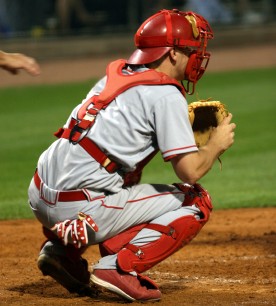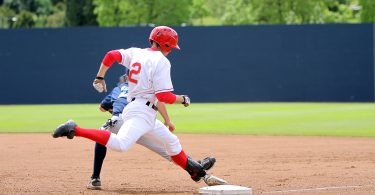The Topic
Catcher block and retrieve technique and mindset
The Situation
There’s a runner on 1st base and 2 outs in the bottom of the seventh inning. The game is tied 1-1 and has big implications for the conference standings. There’s a 1-2 count on the right-handed hitter, who steps into the box against a righty. The runner at 1st has above average wheels and has already attempted to steal earlier in the count on a pitch that was fouled off.
The Play
The runner at first takes a solid lead and readies himself for the pitch. He’s not stealing, but is expecting an off-speed pitch out of the zone and anticipating a pitch in the dirt, where he will be aggressive. The pitcher comes set. After a long hold, we delivers to the plate. The pitch, a slider, is thrown hard and appears headed for the bottom of the strike-zone before taking a sharp turn into the dirt, as the runner at first expected. The hitter lays off the pitch and the catcher goes down to block it.
The runner at first reads the ball in the dirt and errs on the side of aggression. He takes off for second before having a chance to see the ball kick off the catcher. The catcher blocks the ball to perfection, and it comes to rest just a foot in front of him. He pops up to pick up the ball and glances up to check the runner. As he takes a peek at the moving runner, his hand misjudges the location of the ball slightly and he can’t get a great grip on it. He has to double-clutch as he re-adjusts his grip on the ball. After regaining his grip, he fires a bullet to second base, right on the bag.
The Outcome
The play at second is bang-bang, but the foot gets in there just before the tag. The umpire is on top of the call, and correctly extends his arms to let the runner know he’s safe. The next pitch, the batter lifts a soft flair into the triangle behind first base that no one can get to and the offense takes the lead.
What Went Wrong
This is a textbook play that will come up repeatedly throughout a season. Given all the variables of the situation— an above average runner, willing to be aggressive and take risks to get into scoring position, anticipating the breaking ball in the dirt—every millisecond is going to matter in the outcome of the play. The catcher makes one costly mental mistake that costs him throwing the runner out, and leads to the run scoring on the next pitch.
After a textbook block, the catcher’s mistake is peeking at the runner before gathering the ball and readying himself to make the play. We see this happen often on this exact play or a ball on the ground that any fielder is hurriedly trying to field and throw. If you are not in a position to immediately act (throw), knowing that you are hurried usually causes panic and rushed errors. In this case, the catcher takes his eye off the ball and fumbles it because his attention is elsewhere. Seeing he must throw does little good when he is not in a position to throw in the first place.
The catcher or any other player in a similar situation should always remember the proper order of operations. Just remember the acronym GREAT:
- Gather the ball
- Ready to make the play
- Eyes up
- Assess the situation
- Throw, hold or tag
In this particular instance, the catcher should gather the ball by raking his throwing and glove hand together, while getting his feet in the proper position to execute the throw. To see an example of how to gather the ball, watch from 1min 20 second mark in this video HERE. Practice the GREAT order of operations regularly, make them a habit, and think the game!






